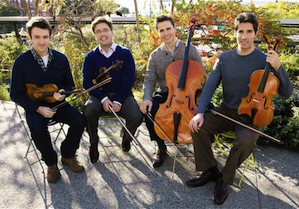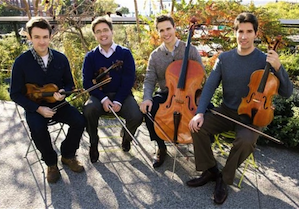
The buzz surrounding the Escher Quartet’s San Francisco debut at the Marines Memorial Theater on Saturday was well-deserved. The New York-based group performs with a cultivation and coherence that belies the players’ youthfulness.
The program began with Mozart’s Quartet in G-major, K387 (nicknamed “Spring,” reminding us of the city’s recent unseasonable weather). The opening measures of the first movement quickly established the musicians’ quality, with sensitive exchanges between Adam Barnett-Hart and Aaron Boyd, the two violinists. The lower strings — violist Pierre Lapointe and cellist Dane Johansen — provided a rich yet subtle canvas for those interactions, without being confined to supporting roles. Indeed, Johansen’s translucent sound characterized one of the most memorable melodic moments in the sprawling and ambitious minuet movement. Some of that verve seeped into the more restrained Andante cantabile, but its songfulness resurfaced as the movement unfolded.
The finale opens with fugue-like imitation among the instruments, though Mozart cheekily refuses to pledge complete allegiance to contrapuntal rigor. Dynamic contrasts abound, as do vertiginous figurations. In particular, Boyd and Lapointe’s understated virtuosity lent these sections elegance rather than outsize athleticism. The ensemble brought the work to an exciting close — so exciting, in fact, that the audience applauded in advance of the actual subdued ending to the piece. It was a fittingly Haydnesque moment, as Mozart dedicated this quartet and the five that followed to his older friend and mentor.
Aaron Boyd commended listeners for their apt gaffe before he introduced the next work on the program, Henri Dutilleux’s Ainsi la nuit (Thus the night). The commentary mitigated an otherwise frustrating lack of program notes. He remarked on the composer’s relative obscurity next to more famous compatriots (such as Messiaen and Boulez). Dutilleux passed away less than one year ago, and one hopes that ensembles such as the Escher Quartet will continue to play his excellent, often understated compositions.
Mozart cheekily refuses to pledge complete allegiance to contrapuntal rigor. Dynamic contrasts abound, as do vertiginous figurations.
Boyd called attention to the nocturnal implications of Ainsi la nuit, speculating that it was a “meditation” on a sense of personal, “interior time.” Though calling for Mozartean sensitivity and refinement, Ainsi la nuit foregrounds texture over melody. The term “pointillistic” is often overused in French contexts; here, however, the adjective seems appropriate. Layers of contrasting textures and timbres were at once distinct yet cohesive, punctuated by the starkly unified moments in the pair of “Litanies” at the heart of the piece.
The first half of the program was an exercise in melodic and textural finesse, which emphasized some of the ensemble’s best qualities. Dvorak’s C-Major Quartet, however, requires a certain Romantic muscularity. While all the members of the Escher Quartet brought a darkness to their sound appropriate for this music, it was Boyd’s and particularly Lapointe’s playing that captivated the ear. Overall, however, Dvorak’s thicker sonorities did not highlight the ensemble’s noteworthy sensitivity as did the Mozart and especially the Dutilleux.
As though that sensitivity extended to telepathy, the quartet chose as an encore the second movement of Ravel’s one work in the genre. Instantly recognizable for its deployment of flashy and extended pizzicato, the movement recalled everything each of these performers had done so well all evening. Subtle coloristic playing and exceptional attentiveness to textural possibility combined to make this encore not merely a closing confection, but instead a tantalizing preview of what the Escher Quartet brings even to beloved chestnuts. They certainly recall their namesake’s mesmerizing graphic complexities, here translated into the sonic realm. It was a pleasure to hear them in this intimate and off-beat venue, although after their excellent San Francisco debut, they will no doubt fill larger halls with many more thoughtful and inventive performances.

